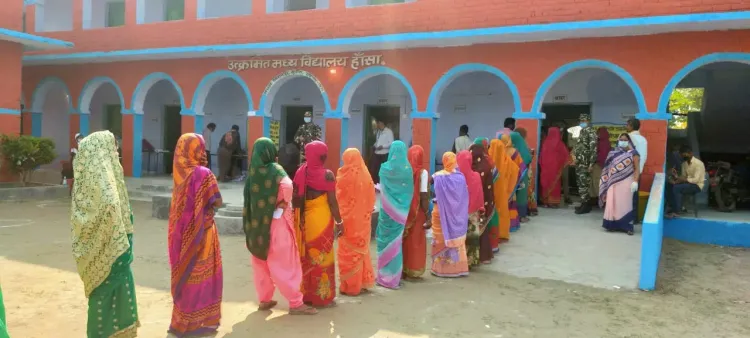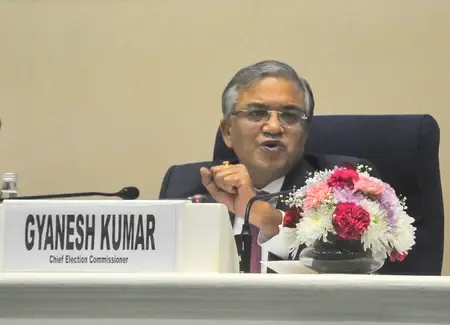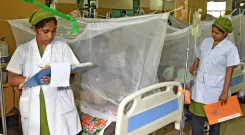Is Nari Shakti Witnessing a Surge in Bihar Assembly Elections Since 2010?

Synopsis
Key Takeaways
- Women voters' participation has increased significantly since 2010.
- Government policies aimed at women's empowerment have had a positive impact.
- Grassroots organizations play a crucial role in raising awareness.
- The gap between male and female voter turnout is narrowing.
- The upcoming elections could further shape Bihar's political landscape.
New Delhi, Nov 6 (NationPress) In Bihar, women voters are proving to be more vocal than previously assumed. Since the 2010 Assembly elections, their voting participation has surpassed that of their male peers, which analysts interpret as recognition of the government's inclusive policies.
Empirical studies and reports indicate that this change in turnout can be linked to initiatives focused on women's welfare and empowerment. Programs such as cash assistance for small enterprises, Jeevika livelihood groups, bicycles for schoolgirls, and reserved seats for women in panchayats have significantly boosted women's social mobility, economic engagement, and political consciousness, thereby enhancing turnout since 2010.
The introduction of direct cash transfers and targeted subsidies has fortified the connection between the state and female voters, transforming them into a dependable voting bloc.
Moreover, grassroots organizations like self-help groups, village institutions, and improvements in girls' education have further elevated social and political awareness.
Data from official sources indicate that in 1962, approximately 32.5% of female voters participated, compared to nearly 55% of male voters.
This gap widened in 1977, even as the Janata Party achieved significant victories in Parliamentary and Assembly elections following extensive protests against the Emergency declared by Prime Minister Indira Gandhi's Congress government.
In Bihar, voters who supported the Janata government under Karpoori Thakur included a staggering 71.2% of males, while only 38.3% of females participated.
During the 1990s, following the Mandal Commission recommendations, several rapid changes occurred at the Centre.
In Bihar, political maneuvering allowed Lalu Prasad Yadav to maintain power, transferring leadership to his wife Rabri Devi when faced with legal troubles over the fodder scam.
This era also marked a gradual reduction in the male-female voter gap within the state's turnout. In the 1990 Assembly elections, around 53.3% of women voted, compared to 69.6% of men.
This period signaled the beginning of 'Lalu raj.' Five years later, the participation gap further decreased, with male turnout dropping to around 67%, while female voter participation rose to 55.8%.
The decade was characterized by Bihar's economy declining to such an extent that a survey in December 1999 labeled it the worst state in India for investment.
In the 1999 Lok Sabha elections, the BJP and Janata Dal (United) formed a coalition that dominated most Assembly segments in the state.
Seeing the fodder scam as detrimental to Lalu Yadav's political prospects, the Congress, which had allied with the RJD in the Parliamentary elections, opted to contest the 2020 Assembly election independently.
In 2000, although the RJD secured a majority of seats, the BJP and JD(U) established a government with Nitish Kumar in charge. However, neither party held a majority in the Assembly.
Notably, in this election, male turnout (70.7%) greatly exceeded female turnout (53.3%). Nevertheless, Nitish resigned before a floor test, leading to Rabri Devi's return as Chief Minister.
The 2005 Assembly elections, held in February, resulted in a fragmented mandate, and no government could be formed in Bihar.
Both male (around 50%) and female (42.5%) participation rates declined.
In the subsequent elections held in October-November of the same year, participation rates fell further to 47% for males and 44.6% for females.
Nitish Kumar reclaimed power at the helm of a JD(U)-BJP coalition government. Since then, in the elections of 2010, 2015, and 2020, approximately 54.4%, 60.5%, and 59.7% of women voters participated, surpassing male turnout rates of 51.1%, 53.3%, and 54.5%, respectively.
As the ongoing Assembly election of 2025 unfolds, early reports from the first phase of polling indicate that a significant number of women voters are participating; however, the identities of their chosen candidates will be revealed on November 14.









